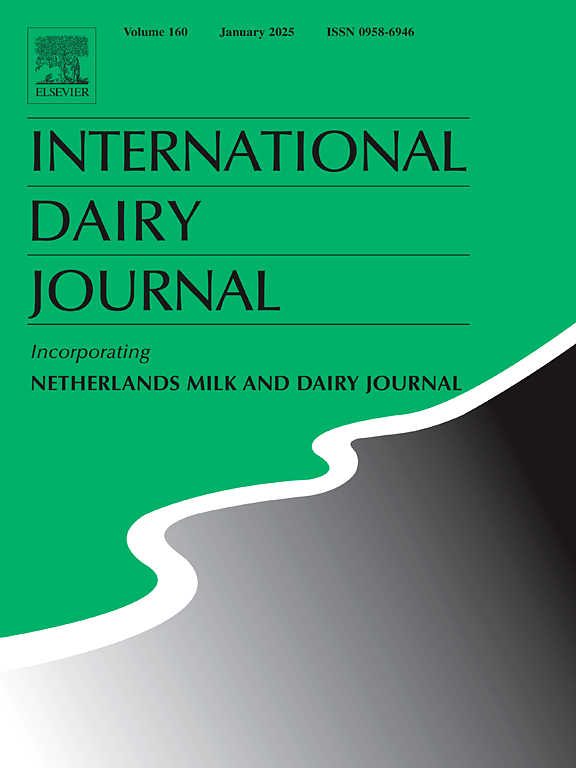文丘里管反应器和液相等离子体对牛奶中大肠杆菌的非热失活:参数优化研究
IF 3.1
3区 农林科学
Q2 FOOD SCIENCE & TECHNOLOGY
引用次数: 0
摘要
牛奶是人类饮食的重要组成部分,但极易受到微生物污染,构成重大安全风险。传统的高温巴氏杀菌,如低温长时间(LTLT)(在63°C下进行30分钟)、高温短时间(HTST)(在85°C下进行2-4秒)、闪蒸巴氏杀菌(在72-75°C下进行15 - 30秒)和在120°C下进行至少15分钟的杀菌过程,虽然有效,但往往会损害牛奶的营养和感官特性。本研究介绍了一种创新的将文丘里管流体动力空化与液相等离子体相结合的非热巴氏灭菌方法,以有效地灭活微生物,同时保持牛奶品质。利用响应面法,我们优化了电压(10-20 kV)、流量(2-8 l/min)、温度(30-50℃)和时间(1-5 min)等参数,以最大限度地减少大肠杆菌。结果显示,大肠杆菌减少5.42对数,电压和时间的影响最大。与可能导致蛋白质变性和脂质氧化的传统方法相比,这种方法以最小的感官变化保存了牛奶的蛋白质、脂肪和乳糖。这种节能技术为工业牛奶巴氏杀菌提供了一种可扩展的替代方案,在确保安全的同时保持营养和感官的完整性。本文章由计算机程序翻译,如有差异,请以英文原文为准。
Non-thermal inactivation of Escherichia coli in milk using a Venturi tube reactor and liquid-phase plasma: A parametric optimization study
Milk is an essential part of the human diet but is highly susceptible to microbial contamination, posing significant safety risks. Conventional thermal pasteurization, such as low-temperature long time (LTLT) (occurs at 63 °C for 30 min), high-temperature short time (HTST) (occurs at 85 °C for 2–4 s), flash pasteurization (occurs at 72–75 °C for 15–30 s) and sterilization process that occurs at 120 °C for at least 15 min, while effective, often compromises milk's nutritional and sensory properties. This study introduces an innovative non-thermal pasteurization method combining Venturi tube hydrodynamic cavitation and liquid-phase plasma for effective microbial inactivation while preserving milk quality. Using response surface methodology, we optimized parameters voltage (10–20 kV), flow rate (2–8 l/min), temperature (30–50 °C), and time (1–5 min) to maximize Escherichia coli reduction. Results showed a 5.42 log reduction in Escherichia coli, with voltage and time being the most influential. Compared to conventional methods, which may cause protein denaturation and lipid oxidation, this approach preserved milk's protein, fat, and lactose with minimal sensory changes. This energy-efficient technology offers a scalable alternative for industrial milk pasteurization, ensuring safety while maintaining nutritional and sensory integrity.
求助全文
通过发布文献求助,成功后即可免费获取论文全文。
去求助
来源期刊

International Dairy Journal
工程技术-食品科技
CiteScore
6.50
自引率
9.70%
发文量
200
审稿时长
49 days
期刊介绍:
The International Dairy Journal publishes significant advancements in dairy science and technology in the form of research articles and critical reviews that are of relevance to the broader international dairy community. Within this scope, research on the science and technology of milk and dairy products and the nutritional and health aspects of dairy foods are included; the journal pays particular attention to applied research and its interface with the dairy industry.
The journal''s coverage includes the following, where directly applicable to dairy science and technology:
• Chemistry and physico-chemical properties of milk constituents
• Microbiology, food safety, enzymology, biotechnology
• Processing and engineering
• Emulsion science, food structure, and texture
• Raw material quality and effect on relevant products
• Flavour and off-flavour development
• Technological functionality and applications of dairy ingredients
• Sensory and consumer sciences
• Nutrition and substantiation of human health implications of milk components or dairy products
International Dairy Journal does not publish papers related to milk production, animal health and other aspects of on-farm milk production unless there is a clear relationship to dairy technology, human health or final product quality.
 求助内容:
求助内容: 应助结果提醒方式:
应助结果提醒方式:


